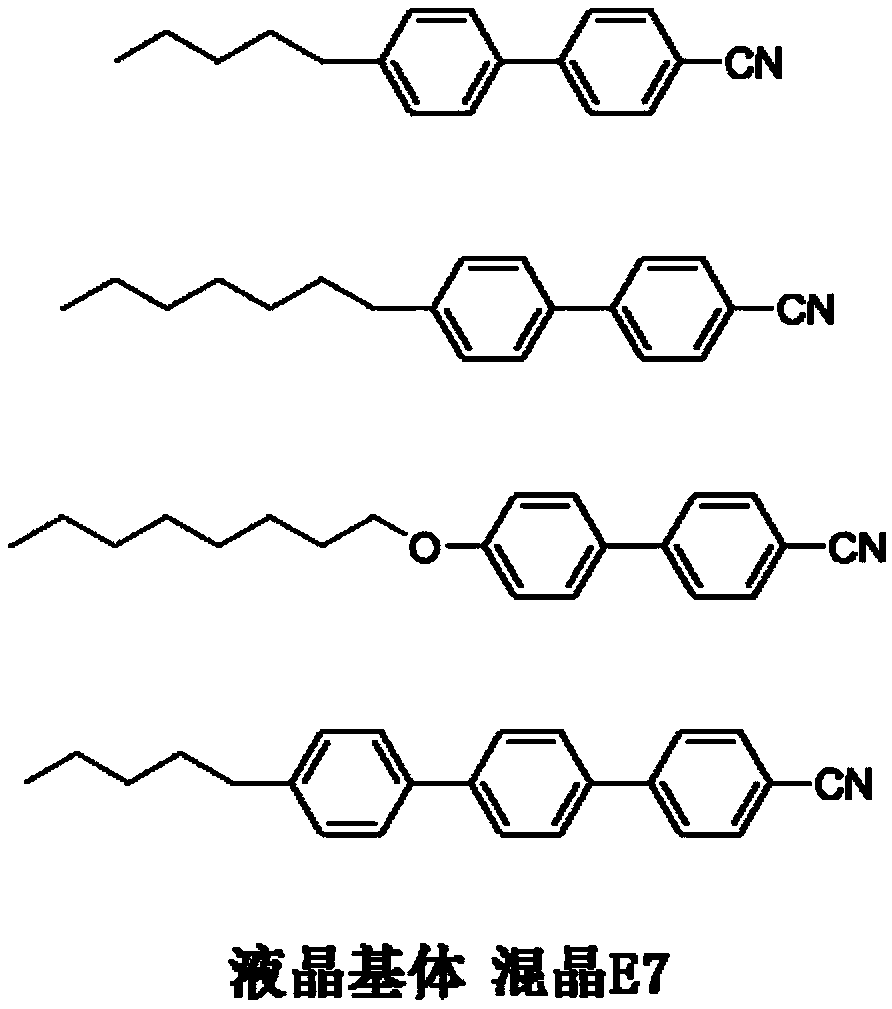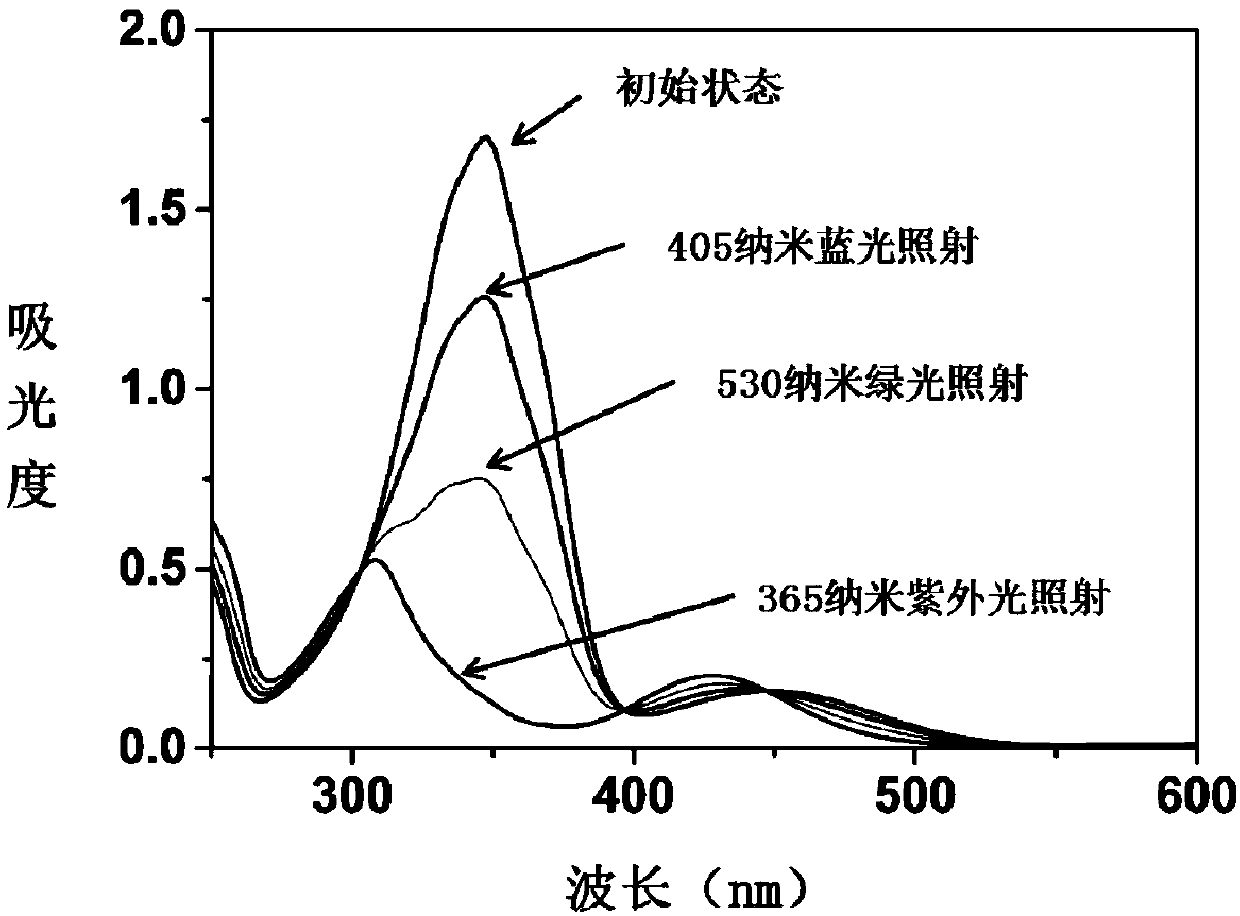Method for controlling liquid crystal reflection color by using fluorine substituted azobenzene
A technology of azobenzene and liquid crystal, which is applied in the field of regulating the reflection color of liquid crystal, and can solve the problems that hinder the practical application of liquid crystal materials, such as red, green and blue primary colors, etc.
- Summary
- Abstract
- Description
- Claims
- Application Information
AI Technical Summary
Problems solved by technology
Method used
Image
Examples
Embodiment 1
[0069] Prepare a fluorine-substituted azobenzene molecule conforming to the general structure, as shown in the following formula:
[0070]
[0071] Add 4-methoxy-2,6-difluoroaniline (5.0 g), hydrochloric acid (15 ml) and aqueous solution (24 mL) into a 500 mL round bottom flask, and cool to 0°C. Under stirring, an aqueous solution (30 mL) of sodium nitrite (3 g) was slowly added dropwise to the system. Then 3,5-difluorophenol (6 g) and sodium hydroxide (5 g) in water (50 mL) were added dropwise. After the dropwise addition was complete, stirring was continued for 3 hours. After adjusting the pH to 4, the reaction solution was filtered, and the filter cake was washed with distilled water to obtain a crude product, which was subjected to column chromatography with dichloromethane as the eluent to obtain an orange solid. Immediately after the product was obtained as an orange solid, the next reaction was carried out. Add orange solid, 1-bromopentane (8g), potassium carbonat...
Embodiment 2
[0074] The fluorine-substituted azobenzene prepared in Example 1 was dissolved in a methylene chloride solution, and at room temperature, the ultraviolet-visible absorption spectrometer was used to detect ultraviolet light at 365 nanometers, green light at 530 nanometers, and blue light at 405 nanometers Changes under irradiation.
[0075] Test results such as image 3 As shown, under the irradiation of different wavelengths of light, the absorption spectrum curves are different. In the initial state, the fluorine-substituted azobenzenes in the system are all trans isomers; under the irradiation of 365 nm ultraviolet light, the absorption peak position at 350 nm is the lowest, and the fluorine-substituted azobenzene trans isomers and cis The ratio of isomers is 1 / 4; under the irradiation of green light at 530 nanometers, the absorption peak at 350 nanometers is in the middle position, and the ratio of fluorine-substituted azobenzene trans isomers and cis isomers in the system...
Embodiment 3
[0077] With the fluorine-substituted azobenzene prepared in embodiment 1, the chiral dopant binaphthyl derivative (structure such as figure 1 Shown) and mixed liquid crystal E7 (structure such as figure 2 Shown) according to the mass ratio of 12% / 7% / 81%, mix evenly and pour in the liquid crystal cell of parallel alignment, at room temperature, use 405 nanometer blue light, 530 nanometer green light, 365 nanometer ultraviolet light to liquid crystal cell Perform irradiation to reach a stable state, use a polarizing microscope to observe the reflection color of the liquid crystal, and use a reflectance spectrometer to measure the position of the reflection peak.
[0078] Test results such as Figure 4 and Figure 5 As shown, under the irradiation of light of different wavelengths, the reflection colors of liquid crystals are different. Under the irradiation of ultraviolet light of 365 nanometers, the reflection color of liquid crystal is red, and the reflection peak is locat...
PUM
 Login to View More
Login to View More Abstract
Description
Claims
Application Information
 Login to View More
Login to View More - R&D
- Intellectual Property
- Life Sciences
- Materials
- Tech Scout
- Unparalleled Data Quality
- Higher Quality Content
- 60% Fewer Hallucinations
Browse by: Latest US Patents, China's latest patents, Technical Efficacy Thesaurus, Application Domain, Technology Topic, Popular Technical Reports.
© 2025 PatSnap. All rights reserved.Legal|Privacy policy|Modern Slavery Act Transparency Statement|Sitemap|About US| Contact US: help@patsnap.com



